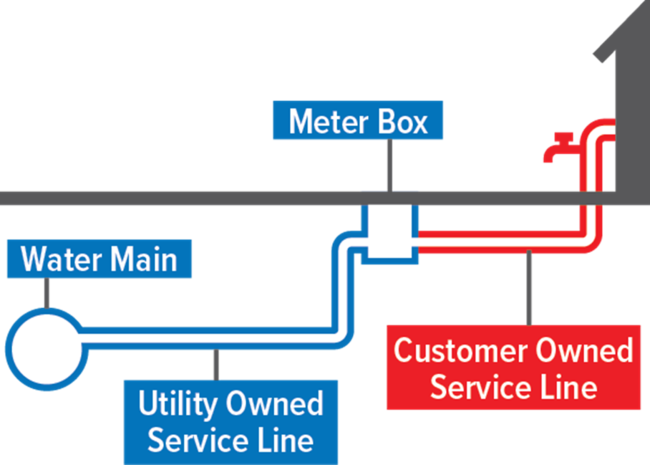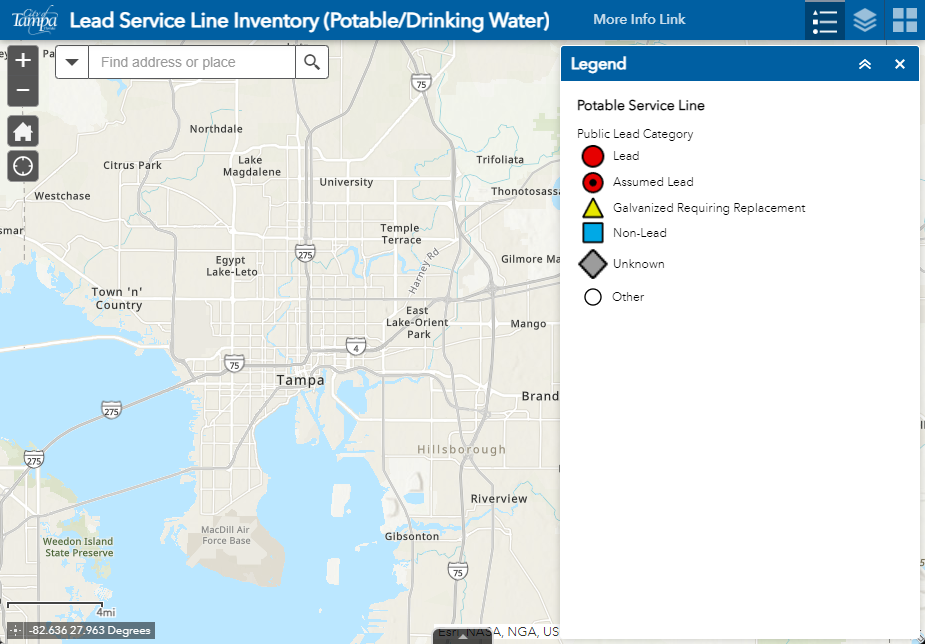The Tampa Water Department is regulated by the U.S. Environmental Protection Agency (EPA) and the Florida Department of Health (FDOH). We strive to be as transparent as possible about the quality of your drinking water. We are proud to say that your drinking water is safe to drink and surpasses all state and federal drinking water standards.
Quick Facts
- The Tampa Water Department has not used lead as a standard piping material.
- Lead is a common metal found in the environment, and drinking water is only one possible source of lead exposure. The main sources of lead exposure are lead-based paint, or lead-contaminated dust, soil, and some plumbing materials. It can also be found in pottery, cosmetics, clothing, toys, or jewelry.
- Lead has a dull, silver-gray color, and is not magnetic. You can quickly check if your pipe is made of lead by:
- Using a magnet (if it sticks or clings to the pipe, it is not lead)
- Doing a visual scratch test with a coin, key, or screwdriver (lead can easily be scratched)

The EPA requires water utilities across the country make a publicly-available inventory of the materials used in their service lines. A service line is the water pipe that connects our water mains to your property. The service line inventory is part of a federal requirement to remove all lead service lines used across the U.S.
Corrosion Control Program
We maintain a strong, proactive corrosion control program to prevent pipes from leaching lead by adjusting the pH of the water before it leaves the water treatment plant. Water with a neutral pH is less likely to interact with lead found in plumbing fixtures, such as pipes and faucets. This reduces the potential for lead to corrode and leach into the drinking water.

Service Line Inventory
The Tampa Water Department is actively working to update the service line inventories provided below – one for Potable (Drinking) Water and one for Fire Protection & Irrigation. These inventories will let you know if your property has a non-lead line, a galvanized line that needs to be replaced*, or a lead line. It will also let you know if your service line material has not yet been identified.
*Galvanized steel piping itself does not pose a risk of lead exposure. However, if it was once connected to lead piping upstream, the rust in galvanized pipes can capture and potentially leach lead into drinking water over time.
Did you receive a notification letter from the Tampa Water Department?
The Tampa Water Department is required to notify customers if part, or all, of the service line material needs to be identified, or if the customer side of the service line needs to be replaced. If you have a confirmed non-lead service line, you will not receive a letter.
One of the following letters have been or will be mailed to you if your service address has a potable (drinking) water service line made of:
- Galvanized material and requires replacement | Spanish version
- Material that needs to be identified on the customer side only | Spanish version
- Material that needs to be identified on the utility side only | Spanish version
- Material that needs to be identified on both the customer side and the utility side | Spanish version
Residents and businesses with service lines that need to be identified will receive letters every year until their service line status is updated.
If you received a letter from us notifying you that your service line material needs to be identified, you can help us identify your service line material by submitting a picture of your water service line to the Self-Assessment Survey in the link below.
You can do a quick check to identify your service line material, or you can contact a licensed plumber.
Visit the Florida Department of Business & Professional Regulation website.
To search for a licensed plumber:
Click "Search by License Type." Then, enter the following information:
- License Category: Construction Industry
- License Type: Certified Plumbing Contractor
- Type in your City or County if you want to search for a local licensed plumber
Make sure the license status is still current.
To verify a plumber's license:
Click “Verify a Licensee” on the left-hand column.
You can search by name or license number to verify professional license.
Optional - Once you select search, you can enter the following information under "Additional Search Criteria":
- License Category: Construction Industry
- License Type: Certified Plumbing Contractor
Once the results are shown, you will be able to see if the license is still current or if it has expired.
Potable (Drinking) Water

Fire Protection & Irrigation
Water serviced through fire protection service lines or irrigation lines is not utilized for drinking water. If you have a separate fire protection line and/or irrigation line, you can view the service line material here:
Please Note
Lead has not been historically detected in the treated water that leaves the City of Tampa water production plant.
Health Effects of Lead
Exposure to lead in drinking water can cause serious health effects in all age groups. Infants and children can have decreases in IQ and attention span. Lead exposure can lead to new learning and behavior problems or exacerbate existing learning and behavior problems.
The children of women who are exposed to lead before or during pregnancy can have increased risk of these adverse health effects. Adults can have increased risks of heart disease, high blood pressure, and kidney or nervous system problems.
How to Reduce Your Risk
If your plumbing system contains lead or galvanized requiring replacement pipes or fixtures, here are some steps you can take to minimize your risk for potential lead exposure:
Boiling water will not reduce lead. Lead dissolves more easily into hot water.
Run cold water for 3 to 5 minutes before drinking or cooking. If the water in the faucet has gone unused for more than 6 hours, lead can dissolve in water.
Do not drink or cook with hot tap water. Lead dissolves more easily into hot water. If you need hot water for cooking, heat cold water on the stove or in the microwave.
Lead particles and sediment from solder or household plumbing can become trapped in your aerator screen located at the tip of your faucet.
Remove and clean your faucet screens, also known as aerators. Flush out any debris in the pipes by running cold water for 3 to 5 minutes before placing the aerators back on the faucet.
Regular cleaning every few months will remove these particles and reduce your potential exposure to lead. This is especially important after household plumbing work and repairs.
- Tampa Water Department customers can request a free indoor water conservation kit which includes bathroom and kitchen sink aerators if you need a replacement.
Flush your pipes after plumbing work. When you upgrade or replace plumbing fixtures or pipes, remove the aerators from each faucet and run cold water for 3 to 5 minutes before placing the aerators back to flush out any debris or sediments.
If you decide to purchase a water filter, be sure it reduces lead – not all filters do. NSF International** created a Consumer Guide to NSF Certified Lead Filtration Devices for Reduction of Lead in Drinking Water.
**NSF International is an independent, not-for-profit organization that writes standards, and tests and certifies products for the food, water, and consumer goods industries to minimize adverse health effects and protect the environment.
Follow manufacturer's instructions for replacing water filters in household appliances, such as refrigerators and ice makers, as well as home water treatment units and pitchers.
Install lead-free faucets and fixtures. Look for lead certification marks indicating the new product is lead-free then replace the old faucets and fixtures. As of January 2014, all pipes, fittings, and fixtures are required to contain less than 0.25 percent lead.
Additional Resources
- FDOH - Information for Homeowners about Lead
- Centers for Disease Control (CDC) - About Lead in Drinking Water
- EPA - Protect Your Tap: A Quick Check for Lead
NSF International** provides information to help consumers identify independently tested and certified drinking water filters and faucets.
**NSF International is an independent, not-for-profit organization that writes standards, and tests and certifies products for the food, water, and consumer goods industries to minimize adverse health effects and protect the environment.
Questions?
If you have questions, want to verify your service line material, or believe a service line may have been categorized incorrectly, contact us at (813) 272-8300.
For more information on reducing lead exposure around your home/building and the health effects of lead, visit EPA's website at epa.gov/lead, call the National Lead Information Center at 1-800-424-LEAD (5323), or contact your healthcare provider.
A copy of our current water quality report is also available in both English and Spanish.
